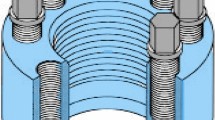Abstract
This paper presents test results from a study on the locking performance of jack bolt nuts with and without added secondary locking. A Junker-type test apparatus is used to apply dynamic transverse force loading to induce loosening. The test data reveal there are two mechanisms of loosening for jack bolt nuts, namely slip of the nut body and slip of the jack bolts. Furthermore, the data show the dominant mechanism of loosening in jack bolt nuts is nut body slip. Since the only currently available option for secondary locking for these types of fasteners is holes in the jack bolts heads for lockwire, additional methods for secondary locking for both mechanisms of loosening are developed and tested. For the test parameters used in this study, it is found that even without any secondary locking, loosening occurs only at relatively low preload levels. The effect of introducing secondary locking to only the jack bolts is a modest decrease in the rate of loosening. The effect of adding secondary locking to only the main nut body is a significant decrease in the rate of loosening. Adding mechanical or adhesive secondary locking to the main nut body and mechanical locking to the jack bolts eliminates loosening even at low preload levels.














Similar content being viewed by others
References
D. Hess, Vibration and shock induced loosening, Chapter 40 in Handbook of Bolts and Bolted Joints (Marcel Dekker, New York, 1998), p.757–824
D. Hess, Threaded fastener secondary locking requirements. J. Fail. Anal. Prev. 17, 724–730 (2017)
NASA-STD-5020B, Requirements for threaded fastening systems in spaceflight hardware, 2021
D. Hess, Threaded fastener locking with safety wire and cotter pins. J. Fail. Anal. Prev. 18, 1216–1223 (2018)
D. Hess, Prevailing torque locking in threaded fasteners. J. Fail. Anal. Prev. 18, 1562–1572 (2018)
C. Cheatham, C. Acosta, D. Hess, Tests and analysis of secondary locking features in threaded inserts. Eng. Fail. Anal. 16, 39–57 (2009)
R Steinbock, Apparatus to mechanically stress a bolt type fastener, United States Patent 4,622,730, 1986
D. Hess, Torque balance, primary locking and loosening in tensioner assembled bolted joints. J. Fail. Anal. Prev. 22, 542–549 (2022)
D. Hess, Tests and analysis on the dynamic loosening of jack bolt nuts compared with heavy hex nuts. J. Fail. Anal. Prev. 23, 2653–2660 (2023)
C DellaCorte, S Howard, D Hess, Preload loss in a spacecraft fastener via vibration-induced unwinding, NASA/TP-2018-219787, 2018
G. Junker, New criteria for self-loosening of fasteners under vibration. Trans. Soc. Autom. Eng. 78, 314–335 (1969)
ISO 16130, Aerospace series—Dynamic testing of the locking behavior of bolted connections under transverse loading conditions (vibration test), International Standard Organization, 2015
NASM20995, Wire, safety or lock, National Aerospace Standard, 1998
SAE AS567K, General practices for use of safety cable, safety wire, key washers, and cotter pins for propulsion systems, Aerospace Standard, 2015
NASM24665, Pin, cotter (split), National Aerospace Standard, 2016
Author information
Authors and Affiliations
Corresponding author
Additional information
Publisher's Note
Springer Nature remains neutral with regard to jurisdictional claims in published maps and institutional affiliations.
Rights and permissions
Springer Nature or its licensor (e.g. a society or other partner) holds exclusive rights to this article under a publishing agreement with the author(s) or other rightsholder(s); author self-archiving of the accepted manuscript version of this article is solely governed by the terms of such publishing agreement and applicable law.
About this article
Cite this article
Hess, D.P. Mechanisms of Loosening and Secondary Locking of Jack Bolt Nuts. J Fail. Anal. and Preven. 24, 575–582 (2024). https://doi.org/10.1007/s11668-024-01859-0
Received:
Revised:
Accepted:
Published:
Issue Date:
DOI: https://doi.org/10.1007/s11668-024-01859-0




